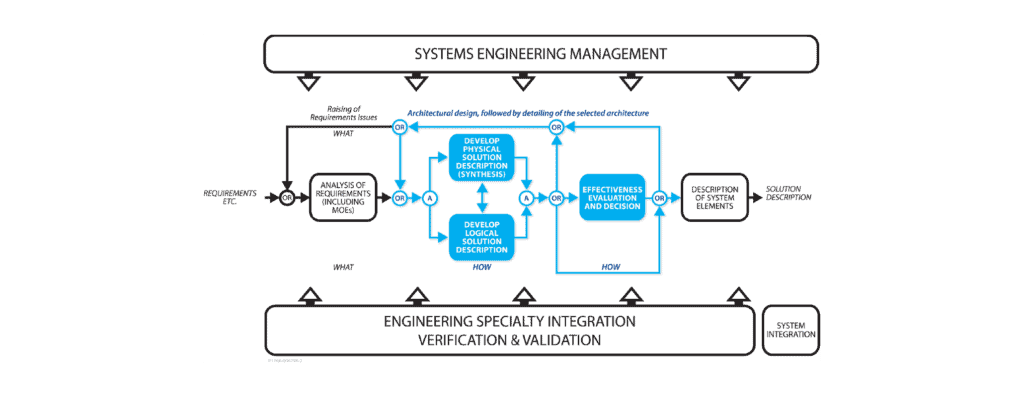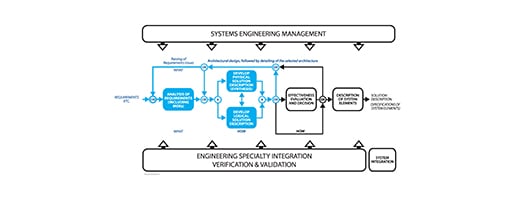Home » Training » Systems Engineering Training Courses » Model-Based Systems Engineering (MBSE) Foundations
Model-Based Systems Engineering (MBSE) Foundations 2-Day
This two-day course places Model-Based Systems Engineering (MBSE) in the context of lifecycle-based system development, explains the benefits of MBSE, and provides learning in the foundation principles, concepts and methods of MBSE support to requirements capture and validation, and to design.
- 2 Days
- Public delivery (Online)
- Corporate delivery (In-person or online)
- Certificate upon completion
- Professional Development Credits
Get Started Today
Register your interest.
Let's Talk
Whether you have a question or are looking to find out more about our training options then please get in touch with us below.
- Summary & Schedule
- Full Schedule
- Course Overview
- Course Outline
 This two-day course places Model-Based Systems Engineering (MBSE) in the context of lifecycle-based system development, explains the benefits of MBSE, and provides learning in the foundation principles, concepts and methods of MBSE support to requirements capture and validation, and to design. In terms of outcomes, this training addresses a critical contributor to project performance, viz. the use of logical modelling:
This two-day course places Model-Based Systems Engineering (MBSE) in the context of lifecycle-based system development, explains the benefits of MBSE, and provides learning in the foundation principles, concepts and methods of MBSE support to requirements capture and validation, and to design. In terms of outcomes, this training addresses a critical contributor to project performance, viz. the use of logical modelling:
a. as an aid to correct problem definition; and
b. to assist designers to work successfully with greater degrees of design complexity, thereby reducing errors and their serious consequences for cost, schedule, and even life and death.
The course provides insight into the realities of current modelling languages and tools, and the directions in which model-based design is evolving.
Participants complete the course equipped individually, and equipped as a team, with actionable methods that can be immediately applied in the workplace, to improve their own performance and that of the company. The evidence is overwhelming that the application of the MBSE foundations taught by PPI correlates strongly with improved project performance where development is involved.
- This course may be credited toward the maintenance of the INCOSE Certified Systems Engineering Professional (CSEP) certification for 16 Professional Development Units and PDUs may be claimed for PMI’s family of certifications, including PMP
- This course qualifies for Engineers Australia and Engineering New Zealand (IPENZ) CPD purposes (16 hours)
- This course may qualify for CPD, CLP and similar purposes with other organizations (16 instructor hours)
Let’s Talk
Whether you have a question or are looking to find out more about our training options then please get in touch with us below.
Register and pay 30 days prior to the course commencement date to receive a 10% early bird discount. Or register a group of 3+ for a 10% group discount. Available for corporate training worldwide.Upcoming Courses
(Exclusive to South Africa)
Upcoming Courses
Register and pay 30 days prior to the course commencement date to receive a 10% early bird discount. Or register a group of 3+ for a 10% group discount. Available for corporate training worldwide.
(Exclusive to South Africa)
Key Learning Objectives
At the conclusion of this course, participants are expected to have learned:
- the overall concepts that are characteristic of MBSE;
- the overall process elements, and their relationships, that collectively constitute the process building blocks to
which MBSE contributes; - how to perform model-based requirements capture and validation, and model-based design, within the
constraints of their technology knowledge and understanding of supporting systems engineering concepts.
Training Method and Materials
The course makes extensive use of course workshops to put into practice the techniques covered in theory sessions.
The course is delivered using a mixture of formal presentations, informal discussions, exercises, and extensive workshops that exercise key aspects of a systems approach to requirements analysis and design, using a single system throughout. The result is a high degree of learning, as evidenced by workshop work products, and the extensive commendations regarding this content received from past participants.
Participants are provided with in hard-copy or soft copy form as applicable to the delivery medium:
- comprehensive course materials containing presentation material and supporting reading material
- numerous supplementary descriptions, checklists, forms and charts which you can put to use immediately; and
complimentary access to Project Performance International’s (PPI’s) evolving Systems Engineering Goldmine and Systems Engineering Tools Database
Some Key Questions
- What is MBSE?
- Where in a system lifecycle can MBSE be used, and to what benefit
- How can MBSE be used to ensure that we develop the right thing?
- What forms of modelling are valuable in requirements analysis, and why?
- How do we realize that value in requirements analysis?
- What forms of modelling are valuable in design, and why?
- What is architecture?
- Is architecture different to design?
- What is logical design, and what forms can it take, and why do we care?
- What is the timing relationship between logical and physical design within MBSE?
- What is model-based architecting? Model-based design? Are model-based and model-driven different?
- What languages and tools are applicable for model-based work?
- What is the significance of SysML V2 versus SysML V1?
- Where does Failure Modes and Effects Analysis (FMEA) figure?
- What are the Knowledge, Skills and Attitudes (KSAs) conducive to success in using MBSE?
Who Should Attend This Course?
This MBSE course is designed for professionals who perform or manage the requirements definition and/or development of small to large technology-based systems, products, capabilities, etc. The course will be of particular value to people with job titles such as:
- Requirements Engineer
- System Architect
- Enterprise Architect
- Design Engineer
- Systems Engineer
- Business Analyst
- Systems Analyst
- Software Systems Engineer
- Software Engineer
- Specialty Engineer – reliability, safety, maintainability, producibility
- Hardware Engineer
- Research Engineer
- Project Engineer
- Logistic Support Analyst (LSA) Specialist
- Industrial Engineer
- Other engineering job titles
- Research and Development (R&D) Manager
- Engineering Manager
Introduction – MBSE Within Systems Engineering (1.5 hours)
- the business case for MBSE within the system lifecycle
- definition of terms
- requirements capture and design interactive exercise – basic
- MBSE within a systems engineering process model
- Requirements Analysis – context, purpose, inputs, outputs
- Logical Design – context, purpose, inputs, outputs and types of logic – functional and state-based
This short introduction presents the business case MBSE and a short overview role and benefits of MBSE throughout a system lifecycle and establishes its context within the bigger picture of systems engineering practice.
2. MBSE for Requirements Capture and Validation (5.5 hours)
- MBSE within requirements capture and validation
- workshop 1 – States and Modes Analysis
- workshop 2 – Functional Analysis
This module exposes in largely interactive and workshop format the two main tools for MBSE support to requirements capture and validation, namely states & modes analysis and functional analysis.
3. Concepts of Architecture and Detailed Design – Physical and Logical (1 hour)
- MBSE within design
- physical architecture (structural view) – basic concepts
- functional form of logical architecture – basic concepts
- functional architecture related to physical architecture
- model-based design in practice – Model-Based Systems Engineering (MBSE)/Model-Based Architecting
(MBA)/Model-Based Design (MBD)/Model-Driven Design (MDD)
This module introduces the basic concepts of architectural and detailed design. The module identifies multiple forms of logical design representation used in MBSE and establishes the relationships between logical architecture/detailed design and physical architecture/detailed design.
4. Initial Physical Conceptualization (0.5 hours)
- the role of technology and innovation
- design complexity trade-off
- interactive exercise – a simple physical design
This module identifies the initial conceptualization of solution alternatives, and their transformation into an initial set of system elements (typically destined to become configuration items).
The interactive exercise of a simple physical design then continues, the aim being to both illustrate and exercise the basics of physical design with a practical example, which then provides the context within which model- based techniques are used. This exercise uses the same system that was the focus of requirements workshops.
5. Functional Design (6.9 hours)
- functional analysis in design – how to do it
• functional analysis/architecture process
• item flow and control flow
• un-allocatable and allocatable functions
• pitfalls in defining functions
• common pitfalls in functional design
• interactive exercise – a simple functional design
• workshop 3 – physical and functional design, part A
• workshop 3 – physical and functional design, part B (optional)
• coupling, cohesion, connectivity
• Failure Modes and Effects Analysis (FMEA)/Failure Modes, Effects and Criticality Analysis (FMECA) in
design
• executable functional design
• performance thread analysis - allocation of functionality between hardware and software
- MBSE languages – SysML 1, SysML 2, proprietary languages
- constructed simulations
- software tools supporting functional and physical design
- pitfalls in functional design
This module of the course delves into the critical detail of logical design (model-based architecting/design), always with reference to the corresponding physical design – as must be the case in the real world of engineering. The focus is on the most widely used – functional – form of logical design, with the exception of software for which state-based design is very widely used.
An overall, effective methodology for maximizing the value of functional design is explained, as are the important concepts of coupling, cohesion and connectivity. These concepts influence the selection of logical design alternatives and their alternative physical implementations.
The interactive exercise of a simple functional design then continues, the aim being to both illustrate and exercise the basics of logical design with a practical example.
A major, team-based workshop is then conducted. The workshop aims to give participants practical experience in exercising the basics of logical design. This workshop also uses the system that was the focus of previous requirements and design workshops.
Languages and the use of constructed simulation are then briefly overviewed.
6. State-Based Design (0.5 hours)
- state-based design – language concepts
- SysML, and alternative languages incorporating state-based modelling
- software tools supporting state-based design
- pitfalls in state-based design
State-based logic is one of the forms of logical architecture identified in Module 2. This module looks at the use of state charts as a technique for logical design that allows for concurrency of states and makes provision for hierarchy of states.
7. Summary and Key Points (0.1 hours)
action plan
More Courses For You
Architectural
Design

Establish & maintain strong system solution relationships
CTI SE-ZERT®

Achieve SE-ZERT Certification
INCOSE SEP Exam Preparation Course 5-Day

Achieve INCOSE SEP Certification
Interface Engineering and Management 2 Days or 4 Half-Days

Avoid interface problems
Model-Based Systems Engineering (MBSE) Foundations 2-Day

Organize your information in standard models for power & reuse
Systems
Engineering

Fulfilling the promise of innovation on demand
Systems Engineering Executive Overview Half-Day

ROI of SE practices
Systems Engineering Management 5-Day

Achieve SE & Program/Project Management alignment
Systems Engineering Overview 3-Day

Develop system solutions
